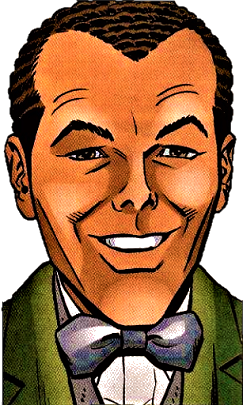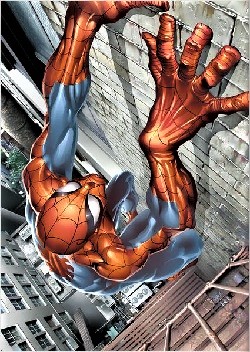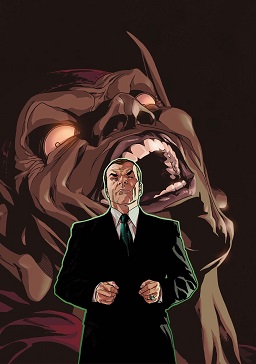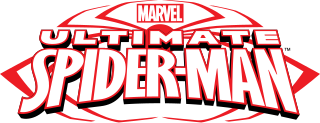
Maybelle "May" Parker-Jameson, commonly known as Aunt May, is a fictional character appearing in American comic books published by Marvel Comics, commonly in association with the superhero Spider-Man. Making her first full appearance in Amazing Fantasy #15, the character was created by writer Stan Lee and artist Steve Ditko, playing an influential role in the Spider-Man comic books.

Gwendolyne Maxine "Gwen" Stacy is a character appearing in American comic books published by Marvel Comics, usually as a supporting character in those featuring Spider-Man. A college student and the daughter of George and Helen Stacy, she is the first romantic interest for Peter following his high school graduation before she is murdered by the Green Goblin. Her death has haunted Peter ever since, and stories published long afterwards indicate she still holds a special place in his heart. Gwen is posthumously subjected to numerous cloning experiments by her former professor Miles Warren, Peter's clone Ben Reilly, and an A.I. of Harry Osborn, the latter resulting in the creation of the Kindreds, and Ben briefly resurrecting Gwen in "Dead No More: The Clone Conspiracy" (2016–2017), with the embodiment of Death herself confirming in Ben Reilly: The Scarlet Spider (2017–2018) that all clones Ben created of deceased people had their souls intact on being brought back, while clones of living people had unique souls of their own. In the alternate realities of Ultimate Marvel and Spider-Gwen, a still-living Gwen respectively becomes their universe's versions of Carnage and Spider-Woman.

Mary Jane "MJ" Watson is a character appearing in American comic books published by Marvel Comics. The character was created by Stan Lee and Steve Ditko, making her first appearance in The Amazing Spider-Man #25, and subsequently designed by John Romita Sr. in #42. Since then, she has gone on to become Spider-Man's main love interest and later his wife. Mary Jane is his most famous and prominent love interest due to their long history, and one of the most iconic in all of comics.

Carnage is a supervillain appearing in American comic books published by Marvel Comics, usually as an adversary of Spider-Man and the archenemy of Venom, in particular the Eddie Brock incarnation of the character, although Carnage and Venom have joined forces when their goals have aligned. The character made its first appearance in The Amazing Spider-Man #361, and was created by writer David Michelinie and artist Mark Bagley, although the first published artwork of Carnage was penciled by Chris Marrinan. Stan Lee would also have some input in the character's name and attributes, pushing for a character who would be far darker and vicious than Venom, due to the latter's more scrupulous character development.

Harold Theopolis "Harry" Osborn is a fictional character appearing in American comic books published by Marvel Comics, commonly in association with the superhero Spider-Man. Created by Stan Lee and Steve Ditko, the character first appeared in The Amazing Spider-Man #31.

Elizabeth "Liz" Allan, also known as Elizabeth Allan-Osborn and commonly misspelled as "Liz Allen", is a fictional character appearing in American comic books published by Marvel Comics. The character was created by Stan Lee and Steve Ditko. In the character's earliest appearances, she was a popular girl at the high school Peter Parker attends. She has been a regular supporting character in the various Spider-Man, Daredevil, and Venom series in an on-and-off basis, and has ties to the Green Goblin and Molten Man. She is married to Harry Osborn, the mother of their son Normie Osborn, and the CEO of Alchemax. Liz Allan would later become Misery upon being bonded to the Symbiote that is a hybrid of the Anti-Venom and Carnage Symbiotes.

George Stacy is a fictional character appearing in American comic books published by Marvel Comics, primarily in association with Spider-Man. He is Gwen Stacy's father and the police captain from the New York City Police Department. Stacy is a strong supporter of Spider-Man, often defending the superhero when others accuse Spider-Man of criminal acts, and thus serves as a foil personality to another Spider-Man related character, J. Jonah Jameson. Stacy's death in The Amazing Spider-Man #90 has been described as a turning point in the Spider-Man saga, signaling to readers that permanent changes could happen in the story, and that the supporting cast was not safe. Stacy was resurrected in a cloned body by Ben Reilly in Dead No More: The Clone Conspiracy (2016–2017), with the embodiment of Death herself confirming in Ben Reilly: The Scarlet Spider (2017–2018) that all clones Ben created of deceased people had their souls intact on being brought back, before Stacy was killed again by the Carrion Virus.

The "Clone Saga" is an extended comic-book storyline published by Marvel Comics, revolving around the superhero Spider-Man and clones of him, as well as of other characters. The second and best-known story arc of this name ran from October 1994 to December 1996, and quickly became one of the most controversial Spider-Man stories ever told. Although it was intended to wrap up in less than a year, the comics sold very well and the writers were encouraged to prolong the saga as long as possible. This led to some changes to the storyline that ultimately proved unpopular. Despite the controversy, the 1990s Clone Saga remains one of the most popular Spider-Man story arcs of all time.

"The Night Gwen Stacy Died", alternatively known as "The Green Goblin's Last Stand", is a story arc of the Marvel Comics comic book series The Amazing Spider-Man #121–122. The two-issue story was written by Gerry Conway, with pencil art by Gil Kane and inking by John Romita Sr. and Tony Mortellaro.

Spider-Man is a superhero appearing in American comic books published by Marvel Comics. He is a modernized, alternate universe counterpart of Spider-Man who is in his youth, a superhero first created by Stan Lee and Steve Ditko in 1962. The Ultimate version of the character originated in Ultimate Marvel, a line of comic books created in 2000 that is set in a parallel universe with a narrative continuity separate and independent from the main continuity of Marvel Comics stories that began in the 1960s.

Ultimate Spider-Woman is a superheroine appearing in American comic books published by Marvel Comics. Created by Brian Michael Bendis and Mark Bagley, she is the Ultimate Marvel equivalent of both the two iterations of Spider-Woman as well as Ben Reilly. As opposed to her prime counterparts, this version of Spider-Woman is a female clone of Peter Parker.

Venom is a character appearing in American comic books published by Marvel Comics. The character is a sentient alien symbiote with an amorphous, liquid-like form, who survives by bonding with a host, usually human. This dual-life form receives enhanced powers and usually refers to itself as "Venom". The symbiote was originally introduced as a living alien costume in The Amazing Spider-Man #252, with a full first appearance as Venom in The Amazing Spider-Man #300.

"Spider-Man" is the name of multiple comic book superheroes from the Marvel Comics Multiverse. The original and most well known is Peter Parker created by Stan Lee and Steve Ditko originating from the Earth-616 universe. Within the mainstream Marvel Universe there have been characters that have taken the mantle such as Ben Reilly, Mac Gargan and Doctor Octopus.

Norman Virgil Osborn is a character appearing in American comic books published by Marvel Comics. Created by writer Stan Lee and artist Steve Ditko, he debuted in The Amazing Spider-Man #14 as the first and best-known incarnation of the Green Goblin. He has since endured as one of the superhero Spider-Man's most prominent villains and is regarded as one of his three archenemies, alongside Doctor Octopus and Venom.

Ultimate Comics: Spider-Man was a monthly comic book series published by Marvel Comics that debuted in September 2011 as part of the second re-launch of the Ultimate Marvel imprint. It followed the "Death of Spider-Man" storyline that concluded the series Ultimate Spider-Man, to which Ultimate Comics: Spider-Man served as a sequel. Written by Brian Michael Bendis and illustrated by Sara Pichelli, the series also served as a continuation of elements from the miniseries Ultimate Comics: Fallout and focuses on the all-new Spider-Man, Miles Morales. The series was set in a continuity shared with other relaunched Ultimate Marvel titles including Ultimate Comics: X-Men and Ultimate Comics: Ultimates. The title ended in October 2013; the adventures of Miles continue in Miles Morales: Ultimate Spider-Man, released in July 2014.

Ultimate Spider-Man is an American superhero animated television series broadcast on the cable network Disney XD, based on the Spider-Man comics published by Marvel Comics. The series featured writers such as Brian Michael Bendis, Paul Dini, and Man of Action.

Spider-Woman is a superhero appearing in American comic books published by Marvel Comics. She was created by Jason Latour and Robbi Rodriguez. The character debuted in Edge of Spider-Verse issue #2 as part of the 2014–15 "Spider-Verse" comic book storyline, leading to the ongoing series Spider-Gwen in 2015.
"Go Down Swinging" is a four-issue comic book storyline in The Amazing Spider-Man, first published by Marvel Comics between March and May 2018 and featuring the fictional superhero Spider-Man. The story overall received generally positive reviews, with critics praising the art, action, and the ending.


















